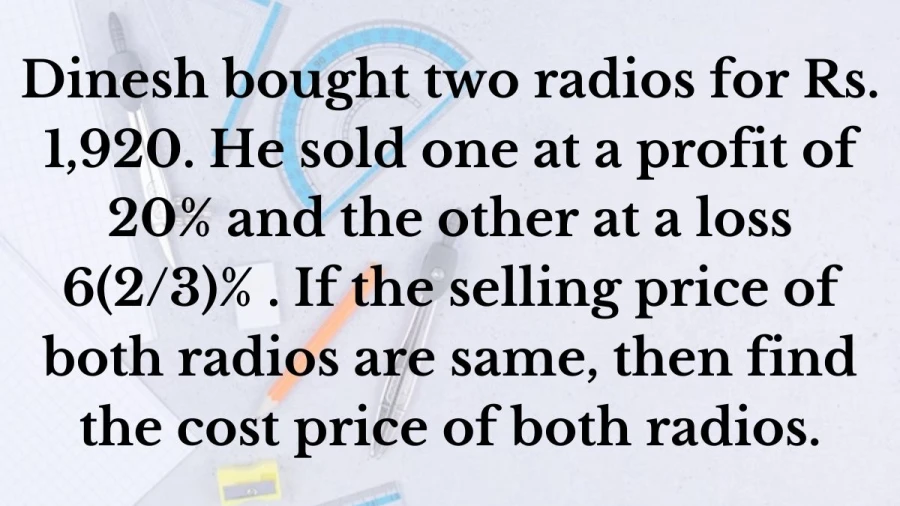If you happen to be viewing the article Dinesh bought two radios for Rs. 1,920. He sold one at a profit of 20% and the other at a loss 6(2/3)% . If the selling price of both radios are same, then find the cost price of both radios. ? on the website Math Hello Kitty, there are a couple of convenient ways for you to navigate through the content. You have the option to simply scroll down and leisurely read each section at your own pace. Alternatively, if you’re in a rush or looking for specific information, you can swiftly click on the table of contents provided. This will instantly direct you to the exact section that contains the information you need most urgently.
Dinesh bought two radios for Rs. 1,920. He sold one at a profit of 20% and the other at a loss 6(2/3)% . If the selling price of both radios are same, then find the cost price of both radios.
The cost prices of the two radios are Rs. 840 and Rs. 1080.
Let’s denote the cost prices of the two radios as x and y.
Given:
-
Dinesh bought two radios for Rs. 1,920. So, x + y = 1920.
-
He sold one at a profit of 20%. Therefore, the selling price of the first radio is 120% of its cost price. Selling price of the first radio = 120/100 * x = 6x/5.
-
He sold the other at a loss of 6(2/3)%. Therefore, the selling price of the second radio is 93(1/3)% of its cost price. Selling price of the second radio = 93(1/3)/100 * y = 28y/30.
Given that the selling prices of both radios are the same, we can equate them: 6x/5 = 28y/30
To make the calculation easier, let’s clear the fractions by multiplying both sides by 30: 30 * (6x/5) = 30 * (28y/30) ⇒ 36x = 28y
Now, we can use the equation x + y = 1920 and the equation 36x = 28y to solve for the values of x and y.
From 36x = 28y, we can express y in terms of x: y = (36/28) * x y = (9/7) * x
Now, substitute this expression for y in the equation x + y = 1920: x + (9/7)x = 1920
Multiply through by 7 to clear the fraction: 7x + 9x = 13440
Combine like terms: 16x = 13440
Now, divide both sides by 16 to find the value of x: x = 13440 / 16 x = 840
Now, we can find the value of y using the equation y = (9/7) * x: y = (9/7) * 840 y = 1080
So, the cost prices of the two radios are Rs. 840 and Rs. 1080, respectively.
Profit and Loss in Mathematics
In mathematics, profit and loss are concepts commonly used in business and economics to measure financial outcomes. Here’s a brief explanation of each:
Article continues below advertisement
Article continues below advertisement
-
Profit: Profit is the financial gain made by a business when the revenue generated from selling goods or services exceeds the total costs incurred in producing those goods or services. Mathematically, profit can be calculated using the formula:
Profit = Revenue – Cost
Where:
- Revenue refers to the total income generated from sales.
- Cost includes all expenses incurred in producing or acquiring goods or services, including production costs, operating expenses, taxes, etc.
-
Loss: Loss occurs when the total costs incurred in producing goods or services exceed the revenue generated from selling them. Mathematically, loss can be calculated using the formula:
Loss = Cost – Revenue
Where the terms “Cost” and “Revenue” have the same meaning as described above for profit.
Both profit and loss can be expressed in monetary terms (e.g., dollars, euros) or as a percentage of the cost or revenue. Understanding profit and loss is crucial for businesses to assess their financial performance and make informed decisions regarding pricing, production, and investment strategies.
Thank you so much for taking the time to read the article titled Dinesh bought two radios for Rs. 1,920. He sold one at a profit of 20% and the other at a loss 6(2/3)% . If the selling price of both radios are same, then find the cost price of both radios. written by Math Hello Kitty. Your support means a lot to us! We are glad that you found this article useful. If you have any feedback or thoughts, we would love to hear from you. Don’t forget to leave a comment and review on our website to help introduce it to others. Once again, we sincerely appreciate your support and thank you for being a valued reader!
Source: Math Hello Kitty
Categories: Math

